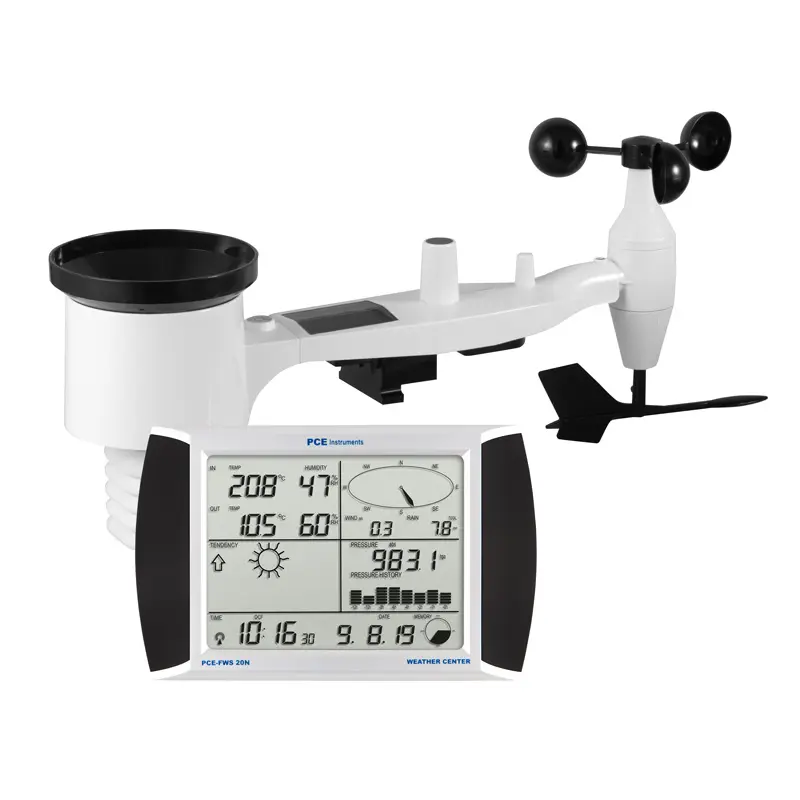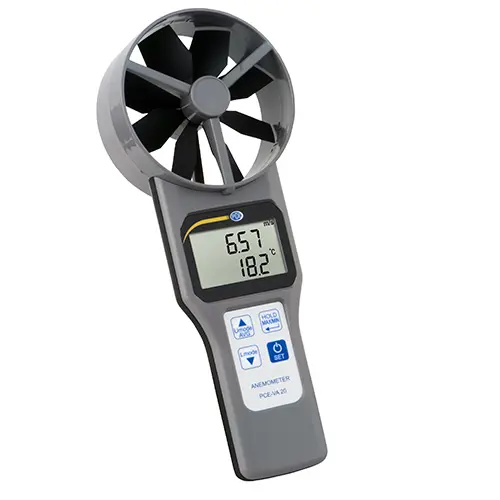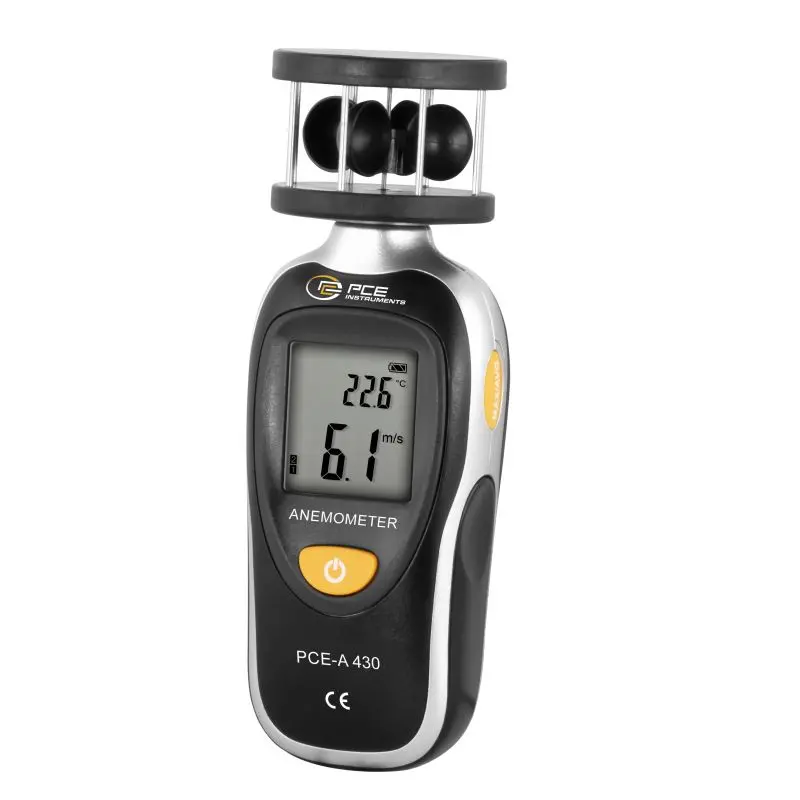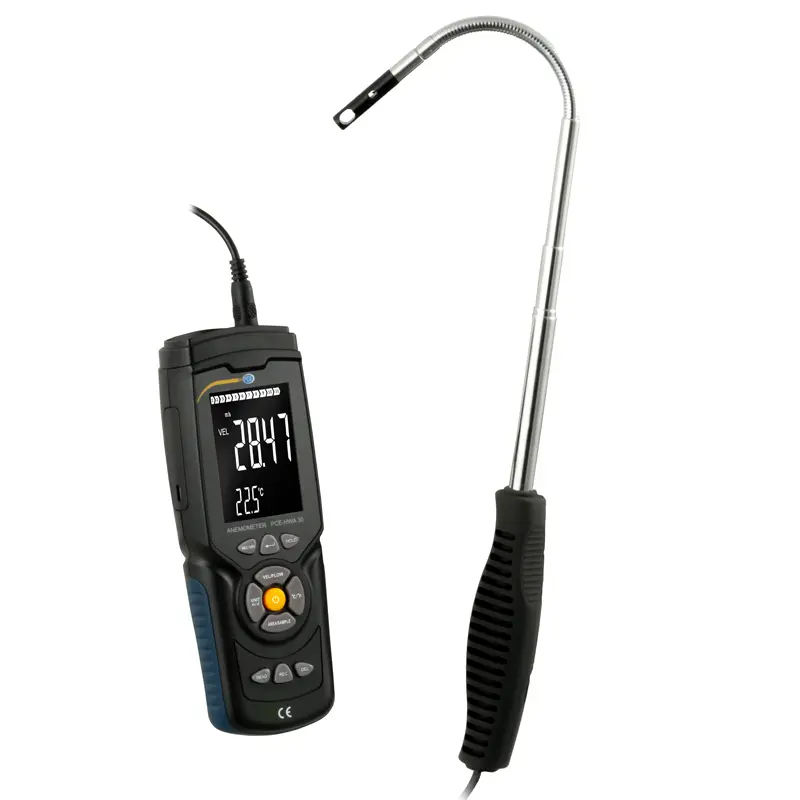Anemometer
An anemometer is an instrument that measures wind speed, providing valuable information for various industries and applications. One type of anemometers is the ultrasonic wind sensor, which uses ultrasonic waves to measure wind speed with high accuracy and reliability.
Another popular option is the anemometer PCE, which offers a range of features such as wind direction measurement, temperature, and humidity sensors. Wind meters are also commonly used for wind speed measurement, providing instant readings in easy-to-read displays.
Accurate wind speed measurement is crucial for many professions, including meteorology, aviation, agriculture, and wind energy. Choosing the right anemometer depends on various factors, including wind speed range, measurement units, response time, and durability. With the right anemometers, you can make informed decisions and stay safe in various weather conditions.
- Indoor temperature in Celsius or Fahrenheit
- Outside temperature in Celsius or Fahrenheit
- Indoor air humidity / outdoor air humidity
- Air pressure gauge in inHg or hPa
- Absolute or relative air pressure display selectable
- Precipitation indication in mm or inch
- Precipitation indicator for 1 hour, 24 hours, 1 week, 1 month
- Wind speed in mph, km / h, m / s, knots …
- Wind direction indicator
- Wind chill temperature gauge
- Weather forecast, trend indicator, storm warning
- and much more…
- Measures air flow velocity, volume flow, relative humidity, air temperature, dew point temperature and wet-bulb temperature
- Air flow velocity range: 0.2 … 30 m/s (39.4 … 5905.5 fpm)
- Accuracy: ±(1.5% of measured value + 0.3 m/s) when less than 20 m/s, ±(3% of measured value + 0.3 m/s) when more than 20 m/s
- Resolution: 0.1
The cup anemometer enables wind speed measurements up to 105 km/h and can be used for a wide range of applications.
-
Measuring range: 30 m/s
-
Wind speed up to 105 km/h
-
Units: m/s, km/h, kn, mph
-
Temperature measurement in C° / F°
-
Beaufort scale
-
Cup cross – sensor
- Measuring range: 0.3 … 30.0 m/s / 0.98 … 98.4 ft/s
- Probe length: 270 … 990 mm / 10.63 … 38.98 / 29.1″
- Probe diameter: Ø0.8 … 1.2 mm / 0.031 x 0.047″
- Data memory for 960 measured values
- Wind speed
- Volume flow
- Temperature measurement
This vane anemometer is used to measure air speed, air flow, air temperature and infrared (IR) temperature. This multi-functional portable handheld vane anemometer offers a quick response time, allowing for real-time measurement.
- Air speed range: 0.4 … 30 m/s / 0.9 … 67 mph
- Air flow range: 0 … 9999 CFM / CMM
- Air temperature range: -10 … 60°C / 14 … 140°F
- IR temperature range: -50 … 500°C / -58 … 932°F
HighlightThe main advantage of using a handheld cup vane anemometer is that it does not require precise alignment with the wind direction, unlike traditional impeller anemometers. Digital cup vane anemometers can measure wind speed without being affected by wind direction.
- 0.9 to 35.0 m/s
- 2.5 to 126.0 km/h
- 1.4 to 68.0 knots
- 1.6 to 78.2 miles/h
Tips on Buying an Anemometer
Introduction
When it comes to measuring wind speed, an anemometer is an invaluable tool. Whether you’re a weather enthusiast, a professional meteorologist, or someone involved in outdoor activities, choosing the right anemometer is crucial for accurate wind speed measurement. In this comprehensive guide, we’ll provide you with essential tips on purchasing an anemometer, ensuring you make an informed decision tailored to your specific needs.
Table of Contents
1. Understanding Anemometers
2. Types of Anemometers
3. Applications and Use Cases
4. Accuracy and Precision
5. Measuring Range
6. Consideration of Environmental Conditions
7. Digital vs. Analog Anemometers
8. Ease of Use and Portability
9. Additional Features
10. Power Source and Battery Life
11. Budget Considerations
12. Brand Reputation
13. Maintenance and Calibration
14. Choosing the Right Anemometer for Your Needs
15. Conclusion
1. Understanding Anemometers
Anemometers are instruments designed to measure wind speed. They play a vital role in various fields, including meteorology, aviation, environmental monitoring, and outdoor sports. Understanding the basics of how an anemometer works is the first step towards making an informed purchase.
2. Types of Anemometers
Anemometers come in different types, each catering to specific applications. Common types include cup anemometers, vane anemometers, hot-wire anemometers, and sonic anemometers. Knowing the differences between these types will help you choose the one that best suits your requirements.
3. Applications and Use Cases
Consider the specific applications and use cases for which you need an anemometer. Whether it’s for sailing, hiking, weather forecasting, or industrial purposes, different scenarios may require different features and specifications.
4. Accuracy and Precision
Accuracy is paramount when it comes to measuring wind speed. Look for an anemometer with high accuracy and precision to ensure reliable data, especially if your measurements are critical for safety or professional purposes.
5. Measuring Range
The measuring range of an anemometer is the range of wind speeds it can effectively measure. Ensure the anemometer you choose covers the full spectrum of wind speeds you anticipate encountering.
6. Consideration of Environmental Conditions
Anemometers are often used in diverse environmental conditions. Consider factors such as temperature, humidity, and altitude to ensure the chosen anemometer can perform reliably in various settings.
7. Digital vs. Analog Anemometers
Decide whether you prefer a digital or analog anemometer. Digital models often offer additional features and ease of reading, while analog models may be preferred for simplicity and durability.
8. Ease of Use and Portability
Anemometers should be user-friendly, with clear displays and intuitive controls. Portability is also essential, especially if you need to take your anemometer on the go. Consider size, weight, and ease of handling.
9. Additional Features
Some anemometers come with additional features such as data logging, Bluetooth connectivity, or the ability to measure additional parameters like temperature. Evaluate whether these features align with your needs.
10. Power Source and Battery Life
Consider the power source and battery life of the anemometer. Choose a model with a reliable power source, and if possible, opt for one with a long battery life to minimize interruptions during extended use.
11. Budget Considerations
Establish a budget for your anemometer purchase. While it’s essential to find one that meets your requirements, there are options available at various price points. Striking a balance between features and cost is key.
12. Brand Reputation
Research the reputation of different anemometer brands. Look for reviews and user feedback to gauge the reliability and durability of the products offered by different manufacturers.
13. Maintenance and Calibration
Regular maintenance and calibration are crucial for the accuracy and longevity of an anemometer. Check the manufacturer’s guidelines for recommended calibration intervals and proper maintenance procedures.
14. Choosing the Right Anemometer for Your Needs
After considering all the factors mentioned, evaluate the anemometers available in the market. Compare specifications, read reviews, and, if possible, test the anemometer in conditions similar to those you’ll encounter in your intended use.
15. Conclusion
In conclusion, purchasing an anemometer requires careful consideration of various factors to ensure it meets your specific needs. By understanding the types of anemometers, their applications, accuracy, measuring range, environmental considerations, and other key factors, you can make an informed decision. Remember to prioritize features based on your unique requirements and budget constraints. With the right anemometer, you’ll be equipped to measure wind speed accurately and efficiently for your chosen activities or professional endeavors.







